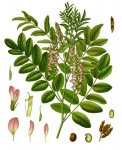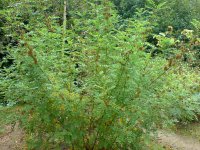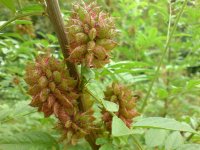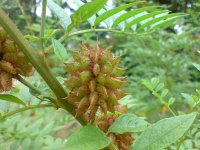Licorice nude - glycyrrhiza glabra
Other names: Liquorice, Licorice naked, Licorice smooth, Licorice.
Family of Legumes (Fabaceae).
Botanical characteristics. Perennial herbaceous plant. It grows on coastal gravels, outcrops, foothills, old deposits, in small groups or singly.
The root is powerful, woody, sweet to the taste. Stem up to 1.2 m tall, slightly branched, bare. Leaves petiolate, odd-pinnate, with early falling lanceolate stipules and with 4-6 pairs of oblong-ovate leaves with a wedge-shaped base and short spicy. The flowers are butterfly, up to 1 cm long, with a purple corolla and a cup covered with acicular glands and scattered hairs, collected in an oblong, up to 4 cm long inflorescence in the axils of the leaves. Fruit - flat, elliptical with straight, thin spines, twisted into a dense globular head, a bean that is self-fracturing when ripe. Blossoms in July - August, fructifies in September - October. There are several species. All species have medicinal properties, for therapeutic purposes can be used similarly.
Spread. In the wild, it grows in the southeast of the European part of the country, in the Caucasus and Central Asia on the banks of rivers, along roads, on sands, like weeds in fields and orchards. Cultivated as a medicinal plant.
Licorice is recommended for introduction into the culture to preserve the species. This plant needs protection.
Used parts of the plant. Medicinal raw materials are rhizomes, the aerial part of the plant, leaves, seeds. The roots are harvested at any time of the year, preferably in spring or autumn. They are chopped to a depth of 30-40 cm, crushed and dried at a temperature of no higher than 50 ° C in dryers. The aerial part is collected during flowering, fruits as they mature.
All parts of the plant contain organic acids (glycyrrhizic acid and its potassium and calcium salts), flavone compounds, glycosides (liquidorinitis, liquiditetigenin, liquidoritoside), vitamins, essential oil, bitterness, coumarins, etc. Sweet taste of licorice is given by saponin-glycyrrhizin (up to 23 %).
The roots of different kinds of licorice are included in all domestic pharmacopoeias and many countries of the world.
Application. Licorice preparations have expectorant, antispasmodic, anti-inflammatory, laxative, diuretic, antihistamine, antitumor properties.
Galenic licorice preparations are widely used in medical practice as an expectorant, enveloping, cough-softening remedy for diseases of the upper respiratory tract, with far-reaching inflammatory manifestations, especially in children and the elderly. They are used as an auxiliary therapy for addison's disease, reduced function of the suprarenal cortex, lupus, allergic dermatitis, and pemphigus.
Preparations of various kinds of licorice "Likvitorit" and "Flakarbin" are recommended as an anti-inflammatory, antispasmodic agent for gastritis , peptic ulcer of the stomach and duodenum. "Glitsira" has a stimulating effect on the function of the adrenal cortex, changes the ratio of sodium and potassium ions in the blood, has anti-allergic properties. It is used for bronchial asthma , hypotonic syndrome of various origins, eczema, dermatitis. In France, the United Kingdom, the United States, patented ointments, powders, injections for all kinds of licorice are used to treat rheumatism, asthma, dermatitis, skin, eye, ear, nose, mouth.
Licorice preparations have antiviral, antispasmodic, anti-inflammatory properties, they show hypotensive, capillary-strengthening, antibacterial, expectorant, antitumor effect; Enveloping, mild laxative. It is used for various diseases: influenza, tuberculosis, diabetes, ulcers, malignant tumors, diseases of the genitourinary system, such as antiviral; Externally - for the treatment of psoriasis, eczema, lupus erythematosus, in cosmetics, to strengthen and grow hair.
Preparation
- Infusion of licorice root naked: 1 tbsp. L. Dry powdered raw material is poured with 1 glass of boiling water and insisted at room temperature for 1 hour. Filter and take 1 tbsp. L. 3 - 4 times a day as an expectorant for colds, bronchitis, asthma, pneumonia.
- Decoction of the rhizome of licorice naked: 1 tbsp. L. Crushed rhizomes pour 1 glass of water and boil for 10 minutes, defend. Drink 1 tbsp. L. 3 times a day or applied externally for irrigation of wounds, applying lotions and pustular wounds.
- Decoction of the rhizome of licorice naked and horsetail field, herb goat's medicinal: 2 tbsp. L. Mixtures of plants taken in equal amounts, pour 0.5 liters of boiling water and boil for 5 minutes. Insist 30 minutes, filter. Drink a third cup 3 times a day for 20 minutes before eating with diabetes.
The finished preparations are used according to the instructions attached to the preparations.
Contraindications. Contraindicated licorice in pregnancy, hypertension, heart failure, obesity.
Use in nutrition. Extract of licorice root is used in the food industry for the preparation of beer, lemonade, kvass. Use licorice also when you drank apples, preparing pastilles.






Comments
When commenting on, remember that the content and tone of your message can hurt the feelings of real people, show respect and tolerance to your interlocutors even if you do not share their opinion, your behavior in the conditions of freedom of expression and anonymity provided by the Internet, changes Not only virtual, but also the real world. All comments are hidden from the index, spam is controlled.